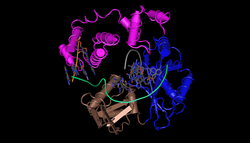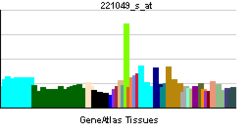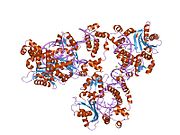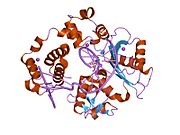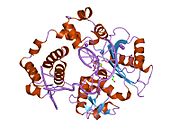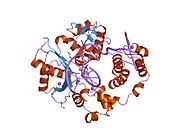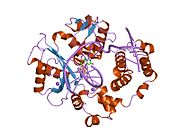- DNA polymerase lambda
-
DNA polymerase lambda, also known as POLL, is a protein that, in humans, is encoded by the POLLA gene.[1][2]
Function
Pol λ is a member of the X family of DNA polymerases. It is thought to resynthesize missing nucleotides during non-homologous end joining, a pathway of DNA double-strand break repair.[3][4] The crystal structure of pol λ shows that, unlike the DNA polymerases that catalyze DNA replication, pol λ makes extensive contacts with the 5' phosphate of the downstream DNA strand. This allows the polymerase to stabilize the two ends of a double-strand break and explains how pol λ is uniquely suited for a role in non-homologous end joining.[5] In addition to NHEJ, pol λ can also participate in base excision repair, where it provides backup activity in the absence of Pol β.[6][7]
Besides its catalytic polymerase domain, pol λ has an 8 kDa domain and a BRCT domain. The 8 kDa domain has lyase activity that can remove a 5' deoxyribosephosphate group from the end of a strand break.[8] The BRCT domain is a phosphopeptide binding domain that is common among DNA repair proteins and is likely involved in coordinating protein-protein interactions.[9] Pol λ is structurally and functionally related to pol μ, another member of the X family that also participates in non-homologous end joining.[10] Like pol μ, pol λ participates in V(D)J recombination, the process by which B-cell and T-cell receptor diversity is generated in the vertebrate immune system. Whereas pol μ is important for heavy-chain rearrangements, pol λ seems to be more important for light-chain rearrangements.[11][12] The yeast Saccharomyces cerevisiae has a single homolog of both pol λ and pol μ called Pol4.[13]
Interactions
Pol λ has been shown to interact with PCNA.[14]
References
- ^ "Entrez Gene: POLL polymerase (DNA directed), lambda". http://www.ncbi.nlm.nih.gov/sites/entrez?Db=gene&Cmd=ShowDetailView&TermToSearch=27343.
- ^ Aoufouchi S, Flatter E, Dahan A, Faili A, Bertocci B, Storck S, Delbos F, Cocea L, Gupta N, Weill JC, Reynaud CA (September 2000). "Two novel human and mouse DNA polymerases of the polX family". Nucleic Acids Res. 28 (18): 3684–93. doi:10.1093/nar/28.18.3684. PMC 110747. PMID 10982892. http://www.pubmedcentral.nih.gov/articlerender.fcgi?tool=pmcentrez&artid=110747.
- ^ Daley JM, Laan RL, Suresh A, Wilson TE (August 2005). "DNA joint dependence of pol X family polymerase action in nonhomologous end joining". J. Biol. Chem. 280 (32): 29030–7. doi:10.1074/jbc.M505277200. PMID 15964833.
- ^ Lee JW, Blanco L, Zhou T, et al. (January 2004). "Implication of DNA polymerase lambda in alignment-based gap filling for nonhomologous DNA end joining in human nuclear extracts". J. Biol. Chem. 279 (1): 805–11. doi:10.1074/jbc.M307913200. PMID 14561766.
- ^ Garcia-Diaz M, Bebenek K, Krahn JM, Blanco L, Kunkel TA, Pedersen LC (February 2004). "A structural solution for the DNA polymerase lambda-dependent repair of DNA gaps with minimal homology". Mol. Cell 13 (4): 561–72. doi:10.1016/S1097-2765(04)00061-9. PMID 14992725.
- ^ Tano K, Nakamura J, Asagoshi K, et al. (June 2007). "Interplay between DNA polymerases beta and lambda in repair of oxidation DNA damage in chicken DT40 cells". DNA Repair (Amst.) 6 (6): 869–75. doi:10.1016/j.dnarep.2007.01.011. PMC 2080795. PMID 17363341. http://www.pubmedcentral.nih.gov/articlerender.fcgi?tool=pmcentrez&artid=2080795.
- ^ Braithwaite EK, Prasad R, Shock DD, Hou EW, Beard WA, Wilson SH (May 2005). "DNA polymerase lambda mediates a back-up base excision repair activity in extracts of mouse embryonic fibroblasts". J. Biol. Chem. 280 (18): 18469–75. doi:10.1074/jbc.M411864200. PMID 15749700.
- ^ García-Díaz M, Bebenek K, Kunkel TA, Blanco L (September 2001). "Identification of an intrinsic 5'-deoxyribose-5-phosphate lyase activity in human DNA polymerase lambda: a possible role in base excision repair". J. Biol. Chem. 276 (37): 34659–63. doi:10.1074/jbc.M106336200. PMID 11457865.
- ^ Yu X, Chini CC, He M, Mer G, Chen J (October 2003). "The BRCT domain is a phospho-protein binding domain". Science 302 (5645): 639–42. doi:10.1126/science.1088753. PMID 14576433.
- ^ Nick McElhinny SA, Ramsden DA (August 2004). "Sibling rivalry: competition between Pol X family members in V(D)J recombination and general double strand break repair". Immunol. Rev. 200: 156–64. doi:10.1111/j.0105-2896.2004.00160.x. PMID 15242403.
- ^ Bertocci B, De Smet A, Berek C, Weill JC, Reynaud CA (August 2003). "Immunoglobulin kappa light chain gene rearrangement is impaired in mice deficient for DNA polymerase mu". Immunity 19 (2): 203–11. doi:10.1016/S1074-7613(03)00203-6. PMID 12932354.
- ^ Bertocci B, De Smet A, Weill JC, Reynaud CA (July 2006). "Nonoverlapping functions of DNA polymerases mu, lambda, and terminal deoxynucleotidyltransferase during immunoglobulin V(D)J recombination in vivo". Immunity 25 (1): 31–41. doi:10.1016/j.immuni.2006.04.013. PMID 16860755.
- ^ Lieber MR (July 2006). "The polymerases for V(D)J recombination". Immunity 25 (1): 7–9. doi:10.1016/j.immuni.2006.07.007. PMID 16860749.
- ^ Maga G, Villani G, Ramadan K, et al. (December 2002). "Human DNA polymerase lambda functionally and physically interacts with proliferating cell nuclear antigen in normal and translesion DNA synthesis". J. Biol. Chem. 277 (50): 48434–40. doi:10.1074/jbc.M206889200. PMID 12368291.
PDB gallery 1nzp: Solution Structure of the Lyase Domain of Human DNA Polymerase Lambda1rzt: Crystal structure of DNA polymerase lambda complexed with a two nucleotide gap DNA molecule1xsl: Crystal Structure of human DNA polymerase lambda in complex with a one nucleotide DNA gap1xsn: Crystal Structure of human DNA polymerase lambda in complex with a one nucleotide DNA gap and ddTTP1xsp: Crystal Structure of human DNA polymerase lambda in complex with nicked DNA and pyrophosphate2bcq: DNA polymerase lambda in complex with a DNA duplex containing an unpaired Dtmp2bcr: DNA polymerase lambda in complex with a DNA duplex containing an unpaired Damp2bcs: DNA polymerase lambda in complex with a DNA duplex containing an unpaired Dcmp2bcu: DNA polymerase lambda in complex with a DNA duplex containing an unpaired Damp and a T:T mismatch2bcv: DNA polymerase lambda in complex with Dttp and a DNA duplex containing an unpaired Dtmp2gws: Crystal Structure of human DNA Polymerase lambda with a G/G mismatch in the primer terminus2pfn: Na in the active site of DNA Polymerase lambda2pfo: DNA Polymerase lambda in complex with DNA and dUPNPP2pfp: DNA Polymerase lambda in complex with DNA and dCTP2pfq: Manganese promotes catalysis in a DNA polymerase lambda-DNA crystalCategories:- Human proteins
- Chromosome 10 gene stubs
Wikimedia Foundation. 2010.

